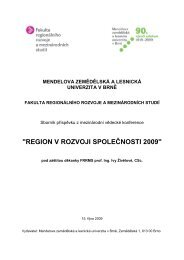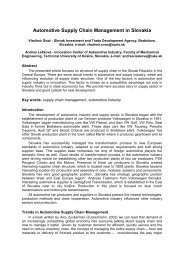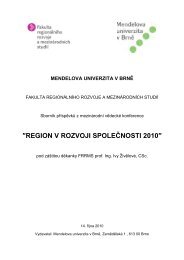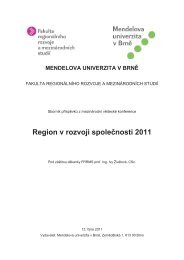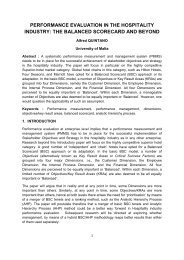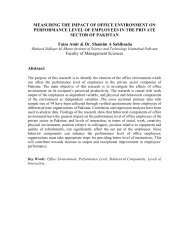Accounting for Intangible Assets and Reporting ... - Icabr.com
Accounting for Intangible Assets and Reporting ... - Icabr.com
Accounting for Intangible Assets and Reporting ... - Icabr.com
You also want an ePaper? Increase the reach of your titles
YUMPU automatically turns print PDFs into web optimized ePapers that Google loves.
<strong>Accounting</strong> <strong>for</strong> <strong>Intangible</strong> <strong>Assets</strong> <strong>and</strong><strong>Reporting</strong> <strong>Intangible</strong> CapitalZuzana KřížováMasaryk UniversityFaculty of Economics <strong>and</strong> AdministrationBrno, Czech Republice-mail: krizovaz@econ.muni.czAbstractDiscussions about the role <strong>and</strong> reliability of in<strong>for</strong>mation of the basic financial accountingstatements continue to be evoked by bankruptcies of large <strong>com</strong>panies or by the ongoingglobal financial crisis. Questions are often asked what causes the profound differencesbetween the accounting <strong>and</strong> the market value of <strong>com</strong>panies. Analyses <strong>and</strong> researchresults in this area often speak about very different ways of human capital management,differences in customer relationships, use of in<strong>for</strong>mation technologies, employeeknowledge or specific corporate organisational cultures. All these “invisible” resourceshave recently been named intangible assets or intellectual capital in literature.<strong>Intangible</strong> assets have been more <strong>and</strong> more interesting not only <strong>for</strong> researchers butmainly <strong>for</strong> <strong>com</strong>pany managers <strong>and</strong> owners. This contribution deals with differences inintangible asset statements pursuant to the International Financial <strong>Reporting</strong> St<strong>and</strong>ards(IFRS) in <strong>com</strong>parison to the United States Generally Accepted <strong>Accounting</strong> Principles (USGAAP) <strong>and</strong> the Czech accounting legislation. The thesis also lists current views <strong>and</strong>trends, terms <strong>and</strong> definitions used in publications on intangible assets <strong>and</strong> intellectualcapital. This article is based on analysis <strong>and</strong> <strong>com</strong>parisons of relevant literature resources,mainly articles <strong>and</strong> conference papers, but also legislative acts <strong>and</strong> monographs.Keywords<strong>Accounting</strong>, reporting, intangible assets, intellectual capital.
IntroductionThe ongoing financial crisis has again <strong>and</strong> again been inspiring numerous discussions inthe media, professional <strong>and</strong> academic <strong>com</strong>munities about the role of financialaccounting <strong>and</strong> audit in corporate governance <strong>and</strong> management of other organisations.The discussions mainly focus on reliability <strong>and</strong> relevance of in<strong>for</strong>mation included in thefinancial statements <strong>and</strong> annual reports. The need of fundamental change in basicfinancial in<strong>for</strong>mation reporting is among other things evidenced by the decision of theUS Securities <strong>and</strong> Exchange Commission (US SEC), which already in August 2007established the Advisory Committee on Improvements to Financial <strong>Reporting</strong> with theaim to define re<strong>com</strong>mendations <strong>for</strong> reduction of the American system of accountingstatements to make them more useful <strong>for</strong> investors. See at SEC's PozenCommittee toMeet Nov (2009).The United States Generally Accepted <strong>Accounting</strong> Principles (hereinafter “US GAAP”) isa set of accounting regulations used <strong>for</strong> preparation <strong>and</strong> submission of financialstatements. These principles are used by <strong>com</strong>panies with publicly traded stock, nonprofitorganisations, governments etc. As follows from the title, they are not exactaccounting procedures but principles stipulating <strong>com</strong>munication between the <strong>com</strong>panymanagements <strong>and</strong> investors. According to Cohn (2009), the total scope of theseaccounting principles has already exceeded 17,000 pages.Another major global accounting system is described by the International Financial<strong>Reporting</strong> St<strong>and</strong>ards (hereinafter “IFRS”). Its origin was called <strong>for</strong> mainly by <strong>com</strong>panygrowth, growth of the number of investors <strong>and</strong> development of security trading on thecapital markets. As we can read in IFRSs in your Pocket 2008 <strong>and</strong> following currentin<strong>for</strong>mation updated as to 18 August 2009 at IFRS are at present used in 117 countriesof the world. The st<strong>and</strong>ards that are part of this system have been issued by theInternational <strong>Accounting</strong> St<strong>and</strong>ards Board (IASB), with the registered office in London,established in 2003. Its activities follow the activities of the International <strong>Accounting</strong>St<strong>and</strong>ards Committee, dealing with <strong>for</strong>mulations of international accounting st<strong>and</strong>ards inthe period 1973 - 2001. This institution has been financed by the central banks, largeaccounting <strong>and</strong> audit firms, financial institutions <strong>and</strong> industrial enterprises through thenon-profit association – the International <strong>Accounting</strong> St<strong>and</strong>ards Board. The members<strong>com</strong>e from nine different countries <strong>and</strong> possess knowledge <strong>and</strong> experience from variousenvironments. The purpose of the institution is to harmonise accounting procedures onthe basis of a single set of high-st<strong>and</strong>ard, <strong>com</strong>prehensible, en<strong>for</strong>ceable <strong>and</strong> globallyacknowledged accounting st<strong>and</strong>ards providing transparent <strong>and</strong> <strong>com</strong>parable in<strong>for</strong>mation.The scope of these accounting principles is currently reported to have reached about2500 pages (Cohn 2009).In the Czech Republic application of the International Financial <strong>Reporting</strong> St<strong>and</strong>ards hasbeen <strong>com</strong>pulsory <strong>for</strong> all accounting units issuing securities registered at the StockExchange <strong>and</strong> at the official RM system market. The other accounting units use Czechaccounting legislation represented by Act no. 563/1991 Coll., on <strong>Accounting</strong>, itsexecutive decrees <strong>and</strong> Czech accounting st<strong>and</strong>ards.This survey of basic in<strong>for</strong>mation about some of the currently applied accounting systemsis followed in the first chapter of this account by a more detailed analysis of reporting<strong>and</strong> appreciation of intangible assets.The international (IFRS) <strong>and</strong> the numerous still functioning national accounting systemsproduce large quantities of in<strong>for</strong>mation <strong>for</strong> all potential users. According to Boedker,Mouritsen <strong>and</strong> Guthrie (2008) surveys per<strong>for</strong>med in the years 2003 to 2005 byinternational audit <strong>and</strong> consultancy firms (Accentures, Deloitte <strong>and</strong> McKinseyConsulting) show, however, that the managers <strong>and</strong> the investors feel lack of in<strong>for</strong>mation<strong>for</strong> their decision-making <strong>and</strong> consider the indicators <strong>and</strong> financial analyses based onfinancial statement data insufficient. That is why the following part of my work will dealwith new trends <strong>and</strong> approached of the so called Enhanced Business <strong>Reporting</strong>
(hereinafter “EBR”), trying to increase the in<strong>for</strong>mative value of the reported in<strong>for</strong>mationabout <strong>com</strong>panies <strong>and</strong> other organisations, or whole industries <strong>and</strong> even larger units.1. <strong>Intangible</strong> <strong>Assets</strong> <strong>Reporting</strong> in Different <strong>Accounting</strong> Systems<strong>Intangible</strong> assets represent one part of the assets showing significant differences inreporting depending on what accounting system is applied <strong>for</strong> the accounting statementpreparation. After accession of the Czech Republic to the European Union a number ofCzech enterprises had to adopt IFRS <strong>for</strong> their balance sheet preparation instead of theso far used national accounting regulations. But as their tax base has still been basedon the Czech legislation these <strong>com</strong>panies have to report in both systems in parallel.That is why this chapter will deal in detail with the rules of intangible asset reporting inthe individual accounting systems <strong>and</strong> conclude with a <strong>com</strong>parison in the <strong>for</strong>m of a table<strong>and</strong> individual notes.1.1 <strong>Intangible</strong> <strong>Assets</strong> in IFRSSince its origin the IFRS have been primarily focused on <strong>com</strong>munication between<strong>com</strong>panies <strong>and</strong> investors. The st<strong>and</strong>ards have been issued by the International<strong>Accounting</strong> St<strong>and</strong>ards Boards (IASB) <strong>and</strong> contained both the accounting st<strong>and</strong>ardsthemselves (IAS/IFRS) <strong>and</strong> their interpretation (SIC/IFRIC) together with the conceptualframework <strong>for</strong> preparation <strong>and</strong> submission of accounting statements.<strong>Intangible</strong> assets are dealt with by IAS 38 – <strong>Intangible</strong> <strong>Assets</strong>, including criteria <strong>for</strong>recognition, appreciation <strong>and</strong> publication of intangible assets. This st<strong>and</strong>ard becameeffective in 1999 <strong>and</strong> was amended in 2004 .As stated in the publication entitled International St<strong>and</strong>ards of Financial <strong>Reporting</strong>(2005, p. 1596) intangible assets are defined as identifiable non-cash assets withoutphysical essence. The <strong>com</strong>pany may report an intangible asset in its balance sheet if itis intangible asset by definition, if there are probable economic benefits following from it<strong>for</strong> the <strong>com</strong>pany <strong>and</strong> if the asset can be reliably priced. If an item does not meet thesecriteria it is recognised as cost.Features of intangible asset defined by the publication IAS 38 <strong>Intangible</strong> <strong>Assets</strong> asissued at 1 January 2009 are as follows:• Identifiable – the asset is separable from the <strong>com</strong>pany, may be sold, leased etc.or <strong>com</strong>es from contractual or other legal rights,• Controllable – the <strong>com</strong>pany is entitled <strong>for</strong> economic benefits following from theasset <strong>and</strong> can restrict third party access to these benefits,• Bringing future economic benefits – usually revenues from sale or cost saving.If an item is recognised as intangible asset it is first priced by its acquisition costs.Further expenditures after this recognition usually do not meet the asset definition <strong>and</strong>there<strong>for</strong>e are recognised as costs. Acquisition costs, costs of employee training, costs ofadvertising <strong>and</strong> sale support, costs of moving or reorganisation of enterprise are thusdirectly recognised as costs. Expenditures once recognised as costs cannot beactivated anymore in future.<strong>Accounting</strong> st<strong>and</strong>ard distinguish among four types of acquisition of intangible assets <strong>and</strong>two types of in-house generated assets. The types of acquisition of intangible assets areas follows:• The most frequent type of acquisition is purchase from a supplier. Theacquisition price may be represented by the price stipulated by the purchasecontract or in the invoice. Acquisition price may include: import duty, non-
employee wages, registration <strong>and</strong> legal fees, depreciations of patents <strong>and</strong> licences<strong>and</strong> potential interest paid.1.2 <strong>Intangible</strong> <strong>Assets</strong> in US GAAPThe rules of US GAAP are applied by the <strong>com</strong>panies voluntarily, but in some cases theapplication is strictly required by an authority. The Securities Commission (SEC) hasalways required from all players at the US capital market to publish their financialstatements pursuant to US GAAP, only recently also accepting statements based on theIFRS methodology. Like IFRS the US GAAP are not <strong>for</strong>mulated by legislators but byindependent experts. In the case of US GAAP these are represented by the Financial<strong>Accounting</strong> St<strong>and</strong>ards Board (FASB), the non-profit non-governmental organisation withindependent in-house source of financing. This basic in<strong>for</strong>mation has been published byMládek (2005, p. 7 - 9) in his publication Světové účetnictví [Global <strong>Accounting</strong>].The basic characteristics <strong>and</strong> examples included in the following paragraph can befound on the web site of FASB, in the document entitled “Statement of Financial<strong>Accounting</strong> St<strong>and</strong>ards No. 142, Glossary”, on page 105:<strong>Intangible</strong> assets are assets (except <strong>for</strong> financial instruments) without any physicalsubstance.Types of intangible assets include but are not limited to the following:• <strong>Intangible</strong> assets following from the law – patents, copyright, trademarks, tradenames, broadcasting licences etc.• <strong>Intangible</strong> assets following from contracts – agreements with employees,manufacturing agreements, consultancy agreements, publicity agreements,distribution agreements, leasing agreements etc.• <strong>Intangible</strong> assets following from other agreements – licences <strong>for</strong> use of software,licences <strong>for</strong> use of technologies, patents, rights to mining, rights to copy booksetc.• <strong>Intangible</strong> assets following from technology – in-house developed <strong>com</strong>putersoftware, manufacturing processes, technical documentations, drawings,databases• <strong>Intangible</strong> assets following from business relations – list of customers, suppliers,distributors, records on credit trustworthiness of debtors <strong>com</strong>piled by creditorsetc.• Goodwill – Decree no 142 defines goodwill also as excess acquisition value of apurchase unit over the value oft eh sum of the acquired asset <strong>and</strong> the assumedliabilities. There is no negative goodwill pursuant to US GAAP.The aspects relevant <strong>for</strong> asset pricing pursuant to US GAAP include the asset valuefollowing from the transaction. This value reflects the future economic benefitsfollowing from the asset <strong>for</strong> the <strong>com</strong>pany. The paid out amount is thus recognised inassets.If the asset is not purchase but developed in-house, its recognised value may onlyinclude the legal fees, the court fees, patent licensing, <strong>and</strong> similar costs necessary <strong>for</strong>the asset registration <strong>and</strong> legal treatment.1.3 <strong>Intangible</strong> Asset Recognition Pursuant to Czech <strong>Accounting</strong> St<strong>and</strong>ardsIn the Czech Republic application of the International Financial <strong>Reporting</strong> St<strong>and</strong>ards is<strong>com</strong>pulsory <strong>for</strong> all accounting units issuing securities registered on the regulatedsecurities markets of the EU Member States.The intangible asset area is settled in the Czech accounting legislation in St<strong>and</strong>ard no013 Long-Term <strong>Intangible</strong> <strong>and</strong> Tangible <strong>Assets</strong>. This st<strong>and</strong>ard contains definition <strong>and</strong>
pricing of long-term intangible <strong>and</strong> tangible assets, depreciation principles, procedure ofaccount recognition on acquisition, technical valuation <strong>and</strong> asset write off. Like the otherst<strong>and</strong>ards the Czech <strong>Accounting</strong> St<strong>and</strong>ard no 013 is governed by Act no 563/1991 Coll.,on <strong>Accounting</strong>, <strong>and</strong> Decree no 500/2002 Coll., executing some provisions of the<strong>Accounting</strong> Act. These legislative sources represented the basis <strong>for</strong> preparation of thefollowing part of my article.The st<strong>and</strong>ard contains the list of assets defined as long-term intangible assets. Theseinclude establishment costs, intangible results of research <strong>and</strong> development, software,rights of determinable value <strong>and</strong> goodwill. The condition <strong>for</strong> classification as long-termintangible asset is usable life of more than one year <strong>and</strong> the asset value higher than thevaluation limit determined by the accounting unit. This class also includes other longtermintangible assets, long-term intangible work in progress, <strong>and</strong> advances provided <strong>for</strong>this type of assets.• Establishment costs are defined as all expenditures incurred <strong>for</strong> establishment ofthe accounting unit until the moment of its incorporation. These costs include inparticular the court <strong>and</strong> administrative fees, costs of business trips, remuneration<strong>for</strong> mediation <strong>and</strong> advisory services <strong>and</strong> rent. Costs of acquisition of long-termtangible assets <strong>and</strong> inventories, representation costs or costs related to the<strong>com</strong>pany trans<strong>for</strong>mation are not included in the establishment costs.• <strong>Intangible</strong> results of research <strong>and</strong> development (R&D) – <strong>for</strong> results of research<strong>and</strong> development to be eligible <strong>for</strong> inclusion in long-term intangible assets theyneed to be developed by in-house activity <strong>and</strong> intended <strong>for</strong> trading, or acquiredfrom other parties.• Software must be developed in-house <strong>for</strong> the purpose of trading or acquired fromother parties – suppliers.• Rights of determinable value – these are in particular subjects of industrial <strong>and</strong>similar ownership, results of creative activity <strong>and</strong> rights pursuant to speciallegislation, if created by in-house activity <strong>for</strong> the purpose of trading or acquiredfrom other parties. Rights of determinable value include <strong>for</strong> example industrialpatterns, usable patterns, registered trademarks <strong>and</strong> patents.• Goodwill is a positive or negative difference between the valuation of the entity,or its part in the sense of the Commercial Code, acquired by purchase, depositor asset <strong>and</strong> liability appreciation in the context of <strong>com</strong>pany trans<strong>for</strong>mation,except <strong>for</strong> change of legal status of the <strong>com</strong>pany, <strong>and</strong> the sum of the individuallyrevaluated asset items reduced by taken over liabilities.• Other long-term intangible assets include emission permits <strong>and</strong> preferential limits<strong>and</strong> long-term intangible assets not recognised elsewhere. The emission permitsinclude greenhouse gas emission permits, <strong>and</strong> emission reduction units <strong>and</strong>verified emission reductions by project activities regardless the appreciationamount.• Long-term intangible work in progress includes acquired long-term intangibleassets in the period of their acquisition until establishment of the asset conditionsuitable <strong>for</strong> launch of operation.• Provided deposits <strong>for</strong> long-term intangible assets include short-term <strong>and</strong> longtermadvance deposits provided <strong>for</strong> the purpose of acquisition of long-termintangible assets.1.4 Comparison of Czech <strong>and</strong> International <strong>Accounting</strong> St<strong>and</strong>ards Related to<strong>Intangible</strong> <strong>Assets</strong>
The basic difference between Czech <strong>and</strong> international accounting st<strong>and</strong>ards isrepresented by their respective legal frameworks. Both IFRS <strong>and</strong> US GAAP focus onprinciples, <strong>and</strong> thus do not defined exact accounting procedures. The Czech accountingst<strong>and</strong>ards, on the other h<strong>and</strong>, are part of the legislation binding <strong>for</strong> all <strong>com</strong>paniesregistered in the Czech Republic. The appearance of Czech accounting is considerablyaffected by the tax legislation, which may be a source of certain inflexibility of the system<strong>and</strong> may lead to acceptance of st<strong>and</strong>points based on tax considerations rather than onthe concept of faithful <strong>and</strong> fair reflection of a transaction in its essence. The Czechaccounting system is <strong>for</strong>mulated by legislators, which both IFRS <strong>and</strong> US GAAP are<strong>for</strong>mulated by non-governmental non-profit organisation. The Czech accountingregulations are focused on accounting from the tax viewpoint <strong>and</strong> partly from theinvestor viewpoint. On the other h<strong>and</strong> both international accounting systems areprimarily focused on reflection of the reality <strong>for</strong> use by investors.Tab. 1 Selected differences in reporting of intangible assetsArea IFRS US GAAP Czech accountinglegislationDefinitionEvaluationCapitalizationof R&DDepreciationSource: authors resultsEconomic sourcemanaged by a<strong>com</strong>pany that is usedto profitAll costs directly linkedto creation of capital<strong>and</strong> its usageAllowed only costs indevelopmentIt has no physicalvalue, <strong>com</strong>pany willretain na economicadvantage in thefutureAll costs necesseryro register <strong>and</strong>establish legalcontractsForbiddenNot always <strong>com</strong>pulsory Necessery to writeoff capital that has acertain expirationdateNo definition, list anumber of itemsAll direct <strong>and</strong> indirectcosts linked toexploitationAllowed <strong>for</strong> costsboth R&DFollowing regulationsexpressed in the lawThe differences between the Czech <strong>and</strong> the international regulations begin with the verydefinition of intangible assets. While the Czech accounting legislation defines this termby a list of items meting the definition, both IFRS <strong>and</strong> US GAAP define intangible assetsby their properties. Both international systems emphasize the absence of physicalessence of intangible assets, <strong>and</strong> IFRS in addition mention three signs of intangibleassets – they are identifiable, controllable <strong>and</strong> bring future economic benefits. TheCzech st<strong>and</strong>ards on the other h<strong>and</strong> emphasize usable life longer than one year <strong>and</strong> thefact that the asset value is higher than a limit specified by the <strong>com</strong>pany.The list of intangible asset items of the Czech intangible asset definition includeestablishment costs, recognised directly in costs by both international accountingsystems, <strong>for</strong> pursuant to their interpretation they do not bring <strong>and</strong> future benefits to the<strong>com</strong>pany.If the assets are not purchased but developed in-house, the Czech accountingst<strong>and</strong>ards appreciate them on the basis of in-house costs of development. This isconditioned by the purpose of the asset, which is its trading. IFRS distinguish betweenthe research <strong>and</strong> the development stage in this asset type. Only the development stagerelated costs may be activated <strong>and</strong> only after fulfilment of certain conditions (<strong>com</strong>pletionis feasible, the <strong>com</strong>pany possesses sufficient resources <strong>for</strong> the <strong>com</strong>pletion etc.).
US GAAP are the strictest in this area <strong>and</strong> only include in the asset value the costsnecessary <strong>for</strong> the asset registration <strong>and</strong> legal treatment, <strong>for</strong> the other costs are notconsidered specifically identifiable. US GAAP do not consider research <strong>and</strong>development intangible asset at all.The international accounting st<strong>and</strong>ards in one of their interpretations (SIC 3) specificallydeal with costs of web sites. The costs of activities related to an internet applicationdevelopment must be activated. The costs incurred in the course of the planning stage<strong>and</strong> the costs related to operation are recognised as costs only. The Czech accountingst<strong>and</strong>ards do not specifically deal with this.The new developments of the Czech accounting st<strong>and</strong>ards include the so calledgreenhouse gas emission permits. This issue is also settled by IFRIC 3 interpretation.Earlier (Krizova 2008, 2009) we demonstrated, via <strong>com</strong>parison of model examples, thata given <strong>com</strong>pany will report the highest profit when using Czech reporting st<strong>and</strong>ards. Incontrast, the lowest profit will be reported when using US GAAP st<strong>and</strong>ards. Thereported differences may then affect the manner in which the level of <strong>com</strong>pany efficiencyis reported, particularly when using traditional methods of share indexes of rentability.Companies striving to succeed within the European or the world markets need to reporttheir results using methods that are con<strong>com</strong>itantly used by others.2. Wider Specification <strong>and</strong> Definition of <strong>Intangible</strong> <strong>Assets</strong> <strong>and</strong> IntellectualCapitalTerms like intangible assets <strong>and</strong> intellectual capital have been subject of increasinginterest of scientists <strong>and</strong> practical experts. This trend corresponds to the development ofthe <strong>com</strong>petitive business environment, which has discovered the importance ofknowledge as a separate <strong>com</strong>modity allowing <strong>for</strong> coping with resource limitations. Alsothe differences between the market <strong>and</strong> the accounting value of <strong>com</strong>panies suggeststhat significant reasons <strong>for</strong> these differences are “intangible or invisible” in many cases.2.1 Terminology <strong>and</strong> Definitions in Current LiteratureSurveys of intangible assets <strong>and</strong> intellectual capital are classified in many differentways. Pursuant to the study (Kaufmann, Schneider, 2004) of available publications onthe terminology used intangible assets may be divided into four basic groups:• Most authors use the basic term intangible assets, or intangibles, such as B. Lev,F. Gu, L. Canibano, P. Sanches, K. E. Sweiby.• Some groups of authors use the term intellectual capital; they are J. H. Daum<strong>and</strong> others.• The third group of authors slightly modifies the above two basic approaches <strong>and</strong>uses <strong>for</strong> example intangible resources, intellectual property, immaterial values –see <strong>for</strong> example O. Granstr<strong>and</strong>, T. Gunter, C. Kriegbaum <strong>and</strong> currentlyespecially P. Sullivan.• The last group does not introduce any special term <strong>and</strong> only uses the generalword knowledgeAs follows from the above classification, the basic terms <strong>and</strong> definitions in this area arenot yet generally accepted. To further illustrate this variability I would like to add thefollowing two examples:
Sullivan (2000, p. 228) submits a working definition of intellectual capita in the followingwording: “…knowledge that can be converted into profit“. In his opinion intellectualcapital consists of two <strong>com</strong>ponents - human capital <strong>and</strong> intellectual assets.Baruch Lev in his famous work “<strong>Intangible</strong>s – Management, Measurement <strong>and</strong><strong>Reporting</strong>” of 2000 states on page 5: “An intangible asset is a claim to future benefitsthat does not have a physical or financial embodiment. A patent, a br<strong>and</strong>, <strong>and</strong> a uniqueorganizational structure (<strong>for</strong> example, an Internet-based supply chain) that generate costsavings are intangible assets“.According to Sweiby (1997, p. 18) “the difference between the marked value of apublicly held <strong>com</strong>pany <strong>and</strong> its official net book value is the value of its intangible assets.In most <strong>com</strong>panies, the value of intagible assets exceeds the value of tangible assets.”<strong>Intangible</strong> assets are also often defined by a list of their assumed properties, byclassification or sorting, which I will deal with in the following part of my article.Like in the case of the basic terms <strong>and</strong> definitions the authors of publications about IA/IChave not yet reached too much agreement about their sorting, classification orcategorisation. All classifications in effect remain very abstract, thus not offering a realinstrument <strong>for</strong> management <strong>and</strong> use of the intangible assets by corporate managers.A classification which – guessing from the number of quotations – has more significantlyinfluenced other researchers was published in 1997 by L. Edvinsson. This classificationis the simplest, <strong>and</strong> only consists of two basic categories: Human capital <strong>and</strong>Organisational, or Structural capital. Some publications do not provide any classificationat all, or state that a classification would be very difficult.Other authors, with Sweiby, 1997, being one of the most often mentioned <strong>and</strong> quoted,divide intangible assets to three basic groups or levels: employee <strong>com</strong>petence, internalstructure <strong>and</strong> external structure. Studies analysing publications on intangible assetsmostly deal with works by American <strong>and</strong> Western European authors.There are also two more detailed <strong>and</strong> more specified classifications, which are quiteexceptional in this area:• The first is the basic categorisation developed by the American Financial<strong>Accounting</strong> St<strong>and</strong>ard Board <strong>for</strong> the purpose of accounting reporting <strong>and</strong> alreadymentioned in the first part of the article, in the section on the accountingstatement systems. This categorisation distinguishes seven basic categories ofintangible assets based on: technologies, customers, market, employees,contracts, organisation <strong>and</strong> <strong>com</strong>pany status,• The second classification by the German working group investigating intangibleassets in accounting <strong>for</strong> Schmalebach Society includes human, customer,supplier, investment, process, allocation <strong>and</strong> innovation capital (Kaufmann,Schneider, 2004).2.2 Approaches to Appreciation <strong>and</strong> <strong>Reporting</strong> of <strong>Intangible</strong> <strong>Assets</strong> <strong>and</strong>Intellectual CapitalThe wide definition of the basic terms <strong>and</strong> classification shows the large variability in theopinions of researchers on appreciation <strong>and</strong> reporting of intangible assets. A survey firstpublished in 1997 by Sweiby <strong>and</strong> several times updated uses the essential classificationinto four basic groups.Survey of types of appreciations of intangible assets:• Direct Intellectual Capital methods (DIC) are based on the assumption that weare able to recognise the individual basic <strong>com</strong>ponents which are then not difficultto appreciate individually or in aggregate,
• Market Capitalization Methods (MCM) are methods based on the founddifference between appreciation of market capitalisation of the <strong>com</strong>pany <strong>and</strong>accounting appreciation of shareholders´ property,• Return On <strong>Assets</strong> Methods (ROA) use the traditional method of financial analysis<strong>and</strong> <strong>com</strong>parison of the results with the industry means,• Scorecard Methods (SC) present (sometimes appreciate or score) the variouslyidentified intangible assets in tables or diagrams.Methods allowing <strong>for</strong> appreciation of intangible assets in currency units (from the ROA<strong>and</strong> the MCM groups) are conveniently used in whole business mergers <strong>and</strong>acquisitions. They may also be used <strong>for</strong> <strong>com</strong>parisons of different <strong>com</strong>panies within thesame industry. As they are <strong>for</strong> the most part based on accounting principles theyfacilitate <strong>com</strong>munication with accounting <strong>and</strong> finance experts. The main advantages ofthe DIC <strong>and</strong> the SC methods include the possibility to create a more <strong>com</strong>plex <strong>and</strong>impressive image of status of the organisation <strong>and</strong> are more often used by non-profitorganisations <strong>and</strong> public legal entities (Sweiby, 2007).2.3 International Trends <strong>and</strong> Current Development in the Area of EhancedBusiness <strong>Reporting</strong>According to Boedker (2007), Ricceri <strong>and</strong> Guthrie (2008) “a growing number of reportingframeworks <strong>and</strong> measurement models have sought to address the changing in<strong>for</strong>mationrequirements of business executive <strong>and</strong> financial markets. Internationally, the lastdecade has seen the proliferation of a variety of reporting frameworks <strong>and</strong> models“.Tab. 2 International initiatives in enhanced business reportingInitiative Category Req. LevelIASB Management Commentary Broad based In disussion GlobalEBRAustralian quiding principles on Broad based In draft Nationalextended per<strong>for</strong>mance management EBRAustrian Universities Organisations Intellectual MANDATO National<strong>and</strong> Studies ActcapitalRYDanish Guideline on Intellectual Intellectual Voluntary NationalCapital <strong>Reporting</strong>capitalGerman Guideline on Intellectual Intellectual Voluntary NationalCapital StatementscapitalJapanese Intellectual BasedIntellectual Voluntary NationalManagementcapitalMERITUM Guideline (EU)Intellectual Voluntary NationalcapitalUK Operating <strong>and</strong> Finacial Review Broad based Voluntary NationalEBRUS Enhanced Business <strong>Reporting</strong> Broad based Voluntary NationalEBRBalanced Scorecard (Kaplan <strong>and</strong> Intellectual Voluntary CompanyNorton)capital<strong>Intangible</strong> asset monitor (Sweiby) Intellectual Voluntary CompanycapitalValue<strong>Reporting</strong> TM (PwC)Broad basedEBRVoluntary Company
Resource: amended according to Boedker, Mouritsen <strong>and</strong> Guthrie (2008)Table 2 briefly summarises in<strong>for</strong>mation about twelve popular initiatives aimed atimproved reporting of in<strong>for</strong>mation about organisations.The abovementioned groups <strong>and</strong> initiatives deal with in<strong>for</strong>mation reporting on the global,national or corporate level. While the international initiatives are usually connected withalready existing institutions (IASB, OECD), the national groups are often inspired orcoordinated by the government or a ministry (Danish Ministry of Science, GermanFederal Ministry of Economics <strong>and</strong> Labour, Japanese Ministry of Economy, Trade <strong>and</strong>Industry etc).On the corporate level the following instruments are considered most important <strong>and</strong>most elaborate: Balanced scorecard (Kaplan <strong>and</strong> Norton), <strong>Intangible</strong> asset monitor(Sweiby) <strong>and</strong> Value <strong>Reporting</strong> TM (PriceWatterhausCoopers). With a single exceptionthe results, procedures <strong>and</strong> instruments ready to improve quality of the reportedin<strong>for</strong>mation are re<strong>com</strong>mended <strong>and</strong> their use is optional (Boedker, Mouritsen <strong>and</strong>Guthrie, 2008).The single exception is the Austrian University Organisation <strong>and</strong> Studies Act, passed inAustria in 2004. This act introduced the obligation to report intellectual capital as thebasis <strong>for</strong> evaluation of per<strong>for</strong>mance of the universities with planned impact on theirfinancing. It is also Austrian research (e.g. Schaffhauser - Linzatti, 2004) that deals ingreater detail with intellectual capital reporting <strong>and</strong> states that “in<strong>for</strong>mation usage ismade difficult by missing uni<strong>for</strong>mity of terminology <strong>and</strong> definitions“.ConclusionThe differences in intangible asset reporting pursuant to the three abovementionedaccounting systems also reflect in the indicators based on the financial statements, suchas the asset return indicators <strong>and</strong> the equity return indicators. Regarding the volume ofcosts of research <strong>and</strong> development incurred by many <strong>com</strong>panies the method of theirreporting per<strong>for</strong>ms a significant role. In harmony with the trend of the growing share ofintangible assets in the overall assets of the <strong>com</strong>pany it is also very desirable to achieveinternational <strong>com</strong>parability of the <strong>com</strong>panies´ economic results.The issue of harmonisation of st<strong>and</strong>ards is currently resolved both on the level ofharmonisation of the national st<strong>and</strong>ards of the individual countries <strong>and</strong> IFRS, <strong>and</strong> on thelevel of harmonisation of IFRS <strong>and</strong> US GAAP. The harmony between nationalaccounting st<strong>and</strong>ards <strong>and</strong> IFRS within EU is to be achieved by the project of theCommon Consolidated Corporate Tax Base, which should be ac<strong>com</strong>plished by 2011.EU would like to achieve a unified legislation <strong>for</strong> calculations of tax bases <strong>for</strong> the legalentity in<strong>com</strong>e tax calculation, with the rate to be specified by each Member Stateindividually.The International <strong>Accounting</strong> St<strong>and</strong>ards Board, the issuer of IFRS, <strong>and</strong> the Financial<strong>Accounting</strong> St<strong>and</strong>ards Boards, the <strong>com</strong>mittee responsible <strong>for</strong> the issue of US GAAP,signed a Memor<strong>and</strong>um of Underst<strong>and</strong>ing in February 2006. This document includes asequence of steps to be taken to <strong>for</strong>mulate quality <strong>and</strong> <strong>com</strong>patible accountingst<strong>and</strong>ards. The intangible asset area has not been included in the themes <strong>for</strong> short-termconvergence but research <strong>and</strong> discussion in this area have been carried outnevertheless.At present the variability of re<strong>com</strong>mendations <strong>for</strong> reporting elements that are not part offinancial statements continues to grow. For that purpose various instruments in the <strong>for</strong>mof guides, monitors etc. are produced. As my experience shows it might be beneficial tofocus on extension of the "accounting technology", software, such as the eXtendedBusiness <strong>Reporting</strong> Language (XBRL). If this reporting method was used the traditional
financial statements might be <strong>com</strong>plemented with tables with graphical symbols,different colour codes etc.LiteratureAct no 563/1991 Coll., on <strong>Accounting</strong> (Czech accounting legislation)Boedker, C., Mouritsen, J., Guthrie, J. (2008) Enhanced business reporting: internationaltrends <strong>and</strong> possible policy directions. Journal of Human Resource Costing &<strong>Accounting</strong>, 12(1), 14 -25.Cohn, M. (2009) Accountants uncertain about IFRS roadmap. WebCPA. RetrievedAugust 18, 2009, from http://www.webcpa.<strong>com</strong>/newsCzech <strong>Accounting</strong> St<strong>and</strong>ard no 013Edvinsson, L. (1997). Developing intellectual capital at Sk<strong>and</strong>ia, Long Range Planning.Vol. 30, No. 3, pp. 366 – 373Financial <strong>Accounting</strong> St<strong>and</strong>ards Board, Statement of Financial <strong>Accounting</strong> St<strong>and</strong>ardsNo. 142, Glossary, p. 105. Retrieved August 18, 2009, from IAS Plus – Use of IFRS by Jurisdicion 2009 Retrieved August 18, 2009, fromhttp://www.iasplus.<strong>com</strong>/IAS 38 <strong>Intangible</strong> <strong>Assets</strong> as issued at 1 January 2009. Retrieved August 18, 2009, fromhttp://www.iasb.org/IFRSs in your Pocket 2008 [online]. Deloitte, 2008. Retrieved August 18, 2009, fromhttp://www.iasplus.<strong>com</strong>/dttpubs/2008.pdfKaufmann, L, Schneider, Y. (2004). <strong>Intangible</strong>s: a synthesis of current research. Journalof Intellectual Capital, Volume 5, Number 3, pp. 366-388.International <strong>Accounting</strong> St<strong>and</strong>ards (2003). /Mezinárodní st<strong>and</strong>ardy účetníhovýkaznictví/ Translantion. HZ Praha, PrahaKřížová, Z. (2009). Why Are the <strong>Intangible</strong> <strong>Assets</strong> so Interesting <strong>for</strong> RevenueAuthorities? In Global Conference on Business <strong>and</strong> Finance Proceesings, Volume 4,No. Atlantic City, USA.Křížová, Z. (2008). Many Changes in Recognition <strong>and</strong> Depreciation of <strong>Intangible</strong>s. In 4thWorkshop on Visualising, Measuring <strong>and</strong> Managing <strong>Intangible</strong>s <strong>and</strong> intellectual Capital.Hasselt, Belgium: EIASM, pp. 101-111.Lev, B. (2001). <strong>Intangible</strong>s - Management, Measurement <strong>and</strong> <strong>Reporting</strong>, The BrookingInstitution, Washington, DC.Sullivan, P. H. (2000). Value-Driven Intellectual Capital – How to convert Corporate<strong>Assets</strong> into Market Value, Wiley, New York.Mládek, R. (2005). Světové účetnictví: IFRS, US GAAP. Praha: Linde.Schaffhauser - Linzatti, M. (2004). Intellectual capital reporting <strong>for</strong> Austrian universities –a thrilling work in progress. EIASM Workshop on the Process of Re<strong>for</strong>m the UniversityAcross Europe, Sienna.SEC's PozenCommittee to Meet Nov. 2; FASB Votes Six Month Comment Period onLiab-Equity Prelim Views. Retrieved August 18, 2009, fromhttp://www2.financialexecutives.org/
Sedláček, J. (2009). Balancing <strong>and</strong> Valuation of <strong>Intangible</strong> <strong>Assets</strong>. In Proceedings ofinternational scientific conference: Firm <strong>and</strong> <strong>com</strong>petetive enviroment, Brno, pp. 209 –215.Survey of differences between International Financial <strong>Reporting</strong> St<strong>and</strong>ards <strong>and</strong> Czechaccounting legislation; Ernst & Young. 2006. Retrieved August 18, 2009, fromhttp://www.ey.<strong>com</strong>/Sweiby, K. E. (1997). The New Organizational Wealth – Managing <strong>and</strong> MeasuringKnowledge-based <strong>Assets</strong>. B-K Publishers, San Francisco, CA.Sweiby, K. E. (2007). Methods <strong>for</strong> Measuring <strong>Intangible</strong> <strong>Assets</strong>ge. B-K Publishers, SanFrancisco. Retrieved August 18, 2009, from http://www.sveiby.<strong>com</strong>/articles/<strong>Intangible</strong>Methods.htm




